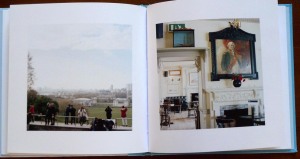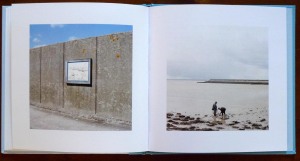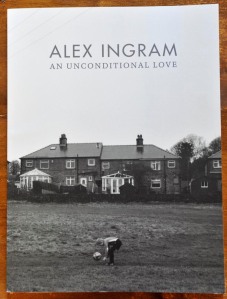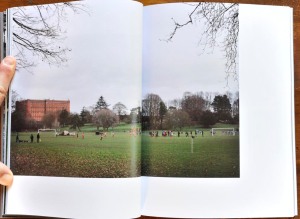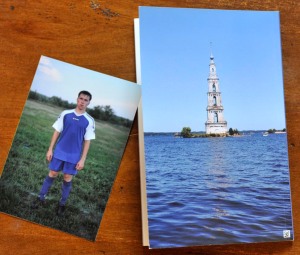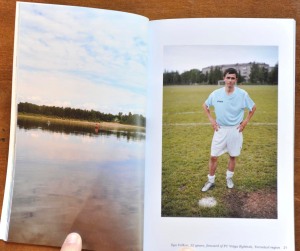Look I’m wearing all the colours, by Rikard Österlund
Posted: November 4, 2018 Filed under: Photobooks, Photography | Tags: England, Look I'm wearing all the colours, Rikard Österlund, selfpublished, Sweden, Zara Leave a commentRikard was born in Sweden and settled in England years ago. In 2005, he met Zara and they’ve been living together until now. This is the story that Rikard Österlund tells us in this very touching book.
But wait, another point of importance in this story, is that Zara suffers from fibromyalgia, hypermobility syndrome, obsessive compulsive disorder and anxiety. This disease is difficult to diagnose, but most importantly, the only treatment is to manage the effects of the disease. When affected, you really have to live with it and Rikard and Zara share this together since the beginning of their relationship. The fact that this disease was known from the beginning of their relationship makes the story more touching and, as Rikard says, they have learnt to live this like a third person in our relationship.
One of the great qualities of this book is that it opens the doors to the intimacy of the couple. But here, the term intimacy has to be read in term of love, not in terme of voyeurism, a bit like if Rikard was afraid to see disappear all these shared moments. The context is set in the preamble of the book, the title is also explained, since it is a sentence that Zara sometimes pronounces when entering the office of Rikard : Look I’m wearing all the colours. The use of colour in the book is not neutral, the story of the couple is an explosion of colours, whether shared moments or as Zara is dressed. But the book is also punctuated with black and white photographs, and it tells a kind of parallel history, like the presence of the unconscious, as for magnified moments, imprecise memories that in the remnant of moments of pain testify a need for the spirit to escape, to wander, to regain strength.
As a result, we quickly feel a great empathy for Zara and Rikard. This form of intimacy does not hide the reality of everyday life, despite the explosion of colors, difficult moments emerge between pages of joy. The suffering of one becomes that of the other and, over this reading, it is also our own.
The book is a long poem dedicated to Zara and its layout uses lots of metaphors, it opens on a blue sky on which clouds are appearing, themselves tainted with warm colors, then, we discover a swan, alone, as in the looking for his partner (we know that swans can stay in couples all their lives), and then, Zara’s face appears behind a window fogged, imprecise and immaterial before seeming to wake up on the next page.
Are we diving into a dream or are we coming out of it? Much more than a book on Zara, this book is a book about Rikard’s love for Zara, whom he compares to a Madonna on a double page with a sweet and tender portrait on the left and a statue on the right. He shows us all his feelings, from doubts to joy or pain, like on this double page with on one side a hospital corridor (no way out) and on the opposite page the shadow profile of Rikard interpreted as we can assume as doubts and fears for the future.
The book ends softly with the beautiful picture of Zara, finally appeased and full of hope, who hands him a flower picked in the garden nearby, and seems to say : do not worry, everything will be fine! And so, we are also a little convinced that, yes, everything will be fine!
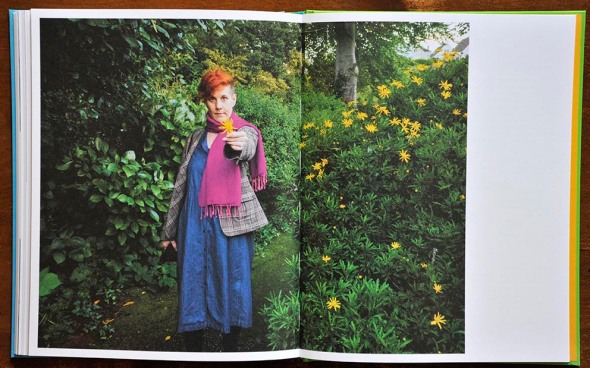
Hardcover book selfpublished in 2018. 120 pages with 90 colour and black and white photographs. Edition of 500 copies.
More info : https://www.rikard.co.uk/allthecolours
Thames : Dark River, Still Shining by Tom Farmer
Posted: August 2, 2015 Filed under: Photobooks, Photography | Tags: Dark river, England, English photography, Gloucestershire, Oxfordshire, photobooks, Thames, Tom Farmer Leave a commentIt is a warm day today in France, so why don’t we go for a walk by the river… 
Documenting the communities living by the River Thames from the source to the sea, through their connections to the river and its surrounding landscapes. This is more or less the purpose of Tom Farmer’s work which was funded via a crowdfunding campaign on Indiegogo. The photographs have been made during the last years and a touring exhibition has started in 2014. Then the idea of a book came out and took ten more months to become real. And here it is, in a ultra limited first edition of 20, which will be probably followed by a second edition very soon !
I like the idea of documenting a community, but the nature of the community did not make the work easy to apprehend. Here we are not in a closed world in the casual sense of « community » with a limit which is defined by the territory, but, like in many communities, the appartenance or the belief is up to everyone. The River Thames has its own existence, a source in Gloucestershire, and 346 kilometers later a mouth in Essex. The name Thames is supposed to mean « dark » whose the title of the book refers to ! When you live by a river, you can choose to live with or without it. You can « grow up » in the floodplain, enjoying all activities induces, or you can just dream to « escape ». This is when you are (or not) part of the community.
There are two main reasons why I really like the book. The first one is very personal : I have a particular relationship with The River Thames since I have been on a summer camp, years ago when I was a teenager, in Wallingford in Oxfordshire. We spent time visiting around but also had some free time for canoeing, which was, of course on the River Thames. I am particularly at ease in the water and this was the only time in my life when I got almost drowned. Since then, I consider myself as part of this community of the Dark River and I don’t blame it. Well, you may already know that I like to add some personal considerations to my book reviews.
The second one, more simple, is a fascination for English photography, especially when it focuses on the Brits and their way of life. In his work, Tom Farmer shows us all the life beside the river. From open landscapes to detailed close-ups of the banks which confines to some intimacy. We’re not on a guide tour but rather with someone who leads you to his very secret and hidden places. You meet boats and find some fishing spots, you discover an old caravan at the bend of a path. In the first part of the book, we are in rural areas and slowly, industrialisation appears. Trees disappear to let the place to concrete buildings. The landscapes change from natural to anthropized and they open. The horizon becomes visible, when not hidden behind a wall and the light also changes. It brightens. But apart in the first photograph, the presence of human beings is always palpable in the photos, wether it is a person herself or the trace of anthropisation (a pylon behind trees…).
Many scenes shown are popular events : a traditional fest, a point of view from Battersea park, regattas, a takeaway van with people queuing…) and all those photos are interspersed with some intimate close-up portraits of inhabitants. They sometimes stare proudly at the camera or don’t pay attention to it, absorbed in their activities. The third typology of photographs is « interiors » photographs. People are photographed inside their home, or empty rooms are shown with what appear to be decorations or trophies hanged on wall. They say a lot about their owners… Last but not least, I also really appreciate the square format of the photographs which does not push the reader in a preconceived formal reading.
Hardcover book with a blue linen and a silkscreen cover, 22 x 22 cm, 60 pages with 45 color photos. Print run of 20 for the first edition.
More info : http://www.tomfarmerphotography.com/
And the gallery where to find the book if some copies remain : www.vortigernmargate.com
All images copyright Tom Farmer, can be removed on request.
The sociology of football : An unconditional love, by Alex Ingram and FC Volga United by Sergey Novikov
Posted: May 9, 2015 Filed under: Photobooks, Photography | Tags: Alex Ingram, Bristol, England, English photography, Europen photography, Football, photobooks, Russia, Sergey Novikov, supporters, Volga 1 CommentIn the mid seventies, as a teenager, one of my biggest concern was football, particularly because, in France, it was the glorious time of « Les verts » the football team of Saint Etienne which gained access, in 1976, to the final of what was then the equivalent of the European champions league. I with my friends had a crazy spring time watching all matches until the last one versus the Bayern who defeated St Etienne 1-0. In those days, every spare moment was dedicated to play with a ball or… to collect Panini stickers and save them in a, seasons after seasons, never finished album. I discovered recently that, nowadays you can buy the missing vignettes from their internet site, clever business !
« Un unconditional love » could have been, at least in the first part, my own story and that’s probably why I like it so much. What Alex Ingram shows us here is the true and honest passion an amateur could have for football in its more noble consideration.
The book is organised around what could be the story of someone. It opens with black and white photos of kids playing in fields, backyard houses. We instantly recognize the English greyness which remind the film Kes by Ken Loach : here the bird is replaced by a ball, but the young boy has real similarities with Billy Casper. So when the « film » begins with the first pictures we’re caught by the story.
Then we move a little further, times are changing and photos are now in color. We follow the teenager, having his first official team shirt, playing his debut matches in front of a couple of spectators, in some almost deserted stadia with not nets for the goals and a burger van for restaurant. All those sequences interlaced so we never really know if we follow one single person or if we have different characters who interact.
The middle part of the book is dedicated to the memories. Of course here are the Panini vignettes which alternate with contemporary photographs shot in studio by Alex Ingram. The confrontation turns to a funny mixture. The old photos are incredibly dated 70’s while the studio photos are modern young women standing in sport suits, showcasing the evolution of this sport which was mainly, or even only, a male game in the 70’s. There is a great attention to the use of color and black and white which emphasizes the passing of time. Amongst the collections of photographs we found some old black and white pictures « from the archives », photos from the 70’s are grainy and faded while the recent ones are bright and colorful. It is in the middle of this section that comes an essay by Senior Lecturer in Sociology David Green who explains his equivocal love for Liverpool team but more generally for football.
To stay on the tracks of the amateurism, the third part is about supporters. We follow them down the streets, wearing scarves, drinking beers, shouting loud or staring sad, depending on the occasion. We meet people alone but also crowds, people chating or watching religiously, respectful or kidding… This is a portrait of the humankind in its glory and decadence. This is what makes all human being lovable with his strengths and weaknesses. We meet babies, young fellows and elderly people, all generations share the same passion for football. Well… This is England !
What is not the less remarkable with this body of work is that nowadays many photographers work on autobiography which is not the case here. Alex has never been a football fan and his work has much to be considered in a documentary style. He was intrigued by the sociological aspects of football in England and focused around his hometown Bristol. In this work, there is a direct filiation with some famous English documentary photographers Daniel Meadows, Chris Killip, Paul Graham (early years) or more recently Ken Grant or Jim Mortram, amongst many others.
Softcover book, 21 x 28 cm, design by Yee Poon, 118 pages, self published in a first edition of 10. A second edition is already planned. Published in 2015.
More info : http://www.alexingramphoto.com/football
This book remind me another very good one published a few years ago. It is called « FC Volga United », by Sergey Novikov. Despite the fact that they are very different, they share a lot. The topic of Sergey’s book is the football clubs all along the Volga river which all got an FC Volga name.
The book comprises three kind of photographs : portraits of players standing on the field and staring proudly to the camera, photos of the Volga river in the nearby area and pictures of the stadia with their surrounding environment and where a competition takes place. Between photos we found texts about the ambiance before, during and after the matches which explain the context with sentences heard around the stadium.
In this book again, what is magnified is the amateurism and the passion for a game. And maybe for us in the Western world, there are some more resonnances due to the magical evocation of the Volga River amongst which is the Red Army Chorus singing the Volga Boatmen or some cinematographic reminiscences from Alexander Nevsky in Nizhny Novgorod.
FC Volga United is a small softcover book, 13,5 x 21 cm, 60 pages. The first edition was limited to 25 and came with a small 10 x 15 cm print. A second edition is available. Published in 2011.
More info : http://sergeynovikov.com/index.php?/projects/fc-volga-united/
All images copryright Alex Ingram and Sergey Novikov.

























